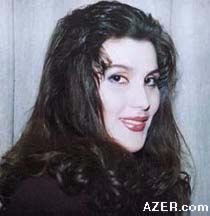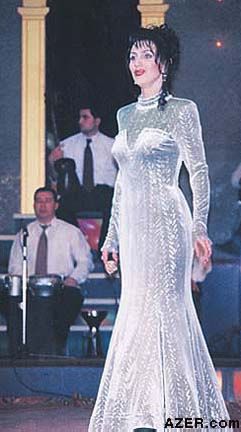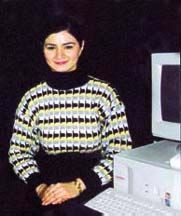|

Spring 2001 (9.1)
Pages
46-47
Traditional Azerbaijani Music with a Beat
by Jean
Patterson

Mugham (pronounced moo-GAHM) is the quintessential form of Azerbaijani
music. Highly improvisational, it is performed in one of seven
basic scales or modes, each one meant to elicit a certain emotion,
according to some music critics. [For more about singing traditional
mugham, see the article about Alim Gasimov in this issue.]
While mugham is still performed in the traditional way, it has
also been fused with other types of music, especially jazz and
classical music. Early in the 20th century, Azerbaijani composer
Uzeyir Hajibeyov took advantage of the improvisational nature
of mugham to create works like the opera "Leyli and Majnun"
(1908), injecting mugham solos-accompanied by traditional regional
instruments such as the tar and kamancha-into the framework of
a Western opera performed primarily by string instruments.
Today, yet another new, fresh version of mugham has appeared
in Azerbaijan: "industrial mugham". The name itself
conjures up images of East vs. West, tradition vs. modernity.
This innovation combines the elements of mugham with the rhythms
of modern "techno-house" music. Basically, it's mugham
that you can dance to - believe it or not!
  In order to find out
what inspired the 1999 album "Industrial Mugham", we
talked to Aytan Ismikhanova, the composer, and Gulyaz
Mammadova, one of the sisters who sings the mughams featured
on the CD. They explain one of the driving forces behind industrial
mugham: to lure younger Azerbaijanis back to their country's
national heritage by combining traditional classical folk music
with the popular new rhythms. In order to find out
what inspired the 1999 album "Industrial Mugham", we
talked to Aytan Ismikhanova, the composer, and Gulyaz
Mammadova, one of the sisters who sings the mughams featured
on the CD. They explain one of the driving forces behind industrial
mugham: to lure younger Azerbaijanis back to their country's
national heritage by combining traditional classical folk music
with the popular new rhythms.
Left:
Mugham singer
Gulyanag Mammadova.
_____
"What would happen if we mixed 'techno-house' music with
traditional Azerbaijani mugham?" wondered Vahid Mustafayev.
Vahid was an avid fan of modern electronic music and had a deep
love for the traditional modal music of his native land. In addition,
as co-founder of the country's most respected independent television
station (ANS), he was used to breathing life into innovative
ideas and watching them evolve into full-scale projects.
Hoping to capitalize on the international popularity of synthesizer-based
dance music, he labeled his experiment "industrial mugham"
and released the first CD by the same name in May 1999.
The idea of industrial mugham wasn't guaranteed to sell. For
one thing, many Azerbaijani youth didn't listen to mugham. They
were much more interested in Western pop music, especially internationally
known singers like Madonna, Ricky Martin, Celine Dion and Enrique
Iglesias.
"Believe me, it's not easy to foster a love for mugham in
the new generation," says Gulyaz Mammadova, a traditional
mugham singer in her late 20s, who appears on the "Industrial
Mugham" CD with her sister Gulyanag. "If you mention
mugham, most young people grimace and say: 'Do you really think
I would listen to mugham?' But if we don't foster a love for
mugham in them, what will happen to mugham in the future? We
must perform mugham and pass it down, generation to generation.
It's a very deep and complex musical genre."
  "We wanted to create
dance music," says Aytan Ismikhanova, the composer for the
album. "But at the same time, we wanted to bring mugham
to our youth, because they don't listen to mugham in its traditional
form." "We wanted to create
dance music," says Aytan Ismikhanova, the composer for the
album. "But at the same time, we wanted to bring mugham
to our youth, because they don't listen to mugham in its traditional
form."
A New Concept
Sisters Gulyaz and Gulyanag Mammadova are known for singing mugham
together. They graduated from the Asaf Zeynalli School of Music.
Left: Sister Gulyaz Mammadova
singing onstage.
Gulyaz tells how they became involved with the "Industrial
Mugham" CD project: "Quite by chance we ran into Vahid
Mustafayev in Shaki [a town in the foothills of the Caucasus
mountains, about five hours northwest of Baku]. He asked us to
sing for him and afterward told us that we were singing in an
old, ancient style, like the old singers did. 'It's true, you
can sing mugham,' he went on, 'but I'm looking for someone innovative,
someone who would dare to synthesize mugham with new forms.'
"At first we didn't quite understand what he meant by mixing
mugham with something modern. Maybe it was because we were used
to singing mugham in the traditional way. When we returned to
Baku, Vahid took us to his own studio - VVS -switched on some
rhythm and said: 'I want you to sing mugham to this rhythm. You
sing. Then Aytan will work with you on it.'"
Aytan's background is in classical music, having graduated from
Baku's famous Music Academy in 1991 and studied the likes of
Bach, Beethoven, Haydn and Rachmaninoff. After she started working
at VVS Studio, Aytan learned to program a synthesizer and began
experimenting with modern compositions.
"They didn't teach us about computers when we went to school,"
she says. "I've had to learn it all on my own. Of course,
I already knew how to compose and write scores for orchestras."
She has since gone on to compose songs not only for Industrial
Mugham but also for the Azerbaijani rap group Dayirman [see article
about Dayirman in this issue].
She remembers how tricky it was to fit all of the elements together:
"It was really quite difficult at the very beginning when
we had just introduced the idea to the sisters. It seemed a bit
strange to them because they weren't used to singing mugham within
any restrictions of rhythm. But this time, they had to adhere
to a strict rhythm - 130 beats per minute. Why this tempo, you
might wonder? Before I started working on this project, I had
listened to a lot of CDs and discovered that 130 beats was the
most frequently used tempo for 'house music'."
Actually, the sisters weren't too sure what the reaction of their
voice teacher, Kamil Vazirov, would be. Since he had grown up
on traditional music, they weren't sure if he would take to these
new innovations or not. But it wasn't long before he accepted
the idea and starting helping the team come up with creative
ideas, especially related to improvisation and the progressions
from one mugham to the other.
The "Industrial Mugham" CD features seven pieces -
each one introducing a different modal pattern: Rast, Shur-shahnaz,
Seygah, Bayati-Shiraz, Humayun, Heyrati and Chahargah. Each song
is seven to nine minutes long. (A regular mugham would last 1/2
hour to 1 hour or more.)
"We've preserved the modal intervals of the melodies so
that the listener can identify the mugham that is being performed,"
Aytan says. "Basically, we've only altered the rhythm and
added drums and bass.
The two sisters sing mugham against this fast tempo and a backdrop
of computer-generated sounds and effects, such as a robot effect
or a telephone effect. Some of Aytan's arrangements also incorporate
Azerbaijani folk instruments such as the tar and kamancha along
with keyboard instruments, violins and occasional bells.
Mugham Video
This idea of mixing Eastern and Western traditions was taken
even further when they produced a video for one of the album's
songs - the Shahnaz mugham. The video, which came out in 2000,
is filmed in several public settings: the Palace of the Khans
in Shaki, around a tandir oven where an old woman is baking bread,
and at the "Inshaatchilar" Metro station in Baku.
  "It took us about
a month to shoot all the footage for the video," Gulyaz
says. "In the various scenes, I represent our national traditions,
while my sister represents modernity. We decided to have the
bread scenes symbolize the natural process of living off the
benefits of one's own hard labor, honestly." "It took us about
a month to shoot all the footage for the video," Gulyaz
says. "In the various scenes, I represent our national traditions,
while my sister represents modernity. We decided to have the
bread scenes symbolize the natural process of living off the
benefits of one's own hard labor, honestly."
Left:
Aytan Ismikhanova,
composer and arranger
for "Industrial Mugham" and the Dayirman Group.
Seyfulla Mustafayev, Vahid's brother, directed the video, and
his daughter played the part of the small child. "She played
her role in the video very well, even though she's only six or
seven years old," Gulyaz says. "Everyone was surprised
at her talent - she did whatever we asked her. When the moment
came to cry, she did it so naturally that we all were touched."
Azerbaijan's "Crazy" dance group also appears in the
video.
At the "Best of the Best" competition, the industrial
mugham video was named "Best Scenario Video of 2000".
The two sisters were awarded "Best Duet of the Year".
Finding an Audience
Industrial mugham seems to be maintaining that delicate balance
between old and new, East and West. And as hoped, the younger
generation is beginning to embrace this new form based on their
own roots. "The reaction to the video has been very positive,"
Gulyaz says. "Wherever we go these days, people beg us to
sing 'Shahnaz'."
Nor have they heard anything negative from famous traditional
mugham singers like Arif Babayev and Alim Gasimov.
Surprisingly, many of the older generation seem to like it, too.
Aytan and the sisters rarely hear any criticism about Industrial
Mugham, though they've been told that some people balk at trying
to dance to it: they find the music so intriguing that they just
want to concentrate and listen to what's going on.
Aytan was surprised when one of her mother's friends asked for
a tape of the music so she could introduce it to her children.
Those who complain the most about the music are radio producers
who have to cope with time restrictions in their programming.
"They don't like that the pieces usually last seven to nine
minutes. That's considered long for radio broadcasting,"
Aytan says.
Aytan believes that there's a difference between the Azerbaijan
of today and that of ten years ago. "Our mentality has changed
since the collapse of the Soviet Union. People have become more
liberated. It used to be that the Soviets prohibited genres like
jazz. We used to be cut off from new musical trends in the international
arena, but now we have access to all kinds of music. Students
travel abroad and exchange ideas. We recognize good music, and
we can listen to it whenever we want. In the past it used to
take three or four years before new musical ideas would find
their way to us. Now we have access to them right away. Thanks
to modern technology, we can visit the Web sites of countless
musicians and singers and immediately listen to their music and
see what they are doing."
While only the future can tell if mugham will make a comeback,
Aytan believes that efforts like the "Industrial Mugham"
CD are vital: "Industrial mugham is like a bridge between
traditional folk music, classical music and the new generation.
This combination of mugham with 'techno-house' will help keep
mugham alive."
Their heads are already spinning with the next project - fusing
mugham with opera! An aria from Bizet's "Carmen" is
their first experiment. Gulyanag will be performing mugham while
Fidan Hajigizi of the Opera Theater joins the duet performing
opera. Two different musical genres. Two languages - Italian
and Azerbaijani - and two magnificent voices. The combination
promises to be amazing!
The "Industrial Mugham" CD can be ordered from Azerbaijan
International at AZER.com. Click on STORE, then MUSIC. Lyrics
from the "Industrial Mugham" article album may be found
at AZERI.org in both Azeri Latin
and English. Click on AZERI LATIN, then MUSIC
LYRICS.
_____
From Azerbaijan
International
(9.1) Spring 2001.
© Azerbaijan International 2001. All rights reserved.
Back to Index
AI 9.1 (Spring 2001)
AI Home
| Magazine Choice | Topics
| Store
| Contact
us
|